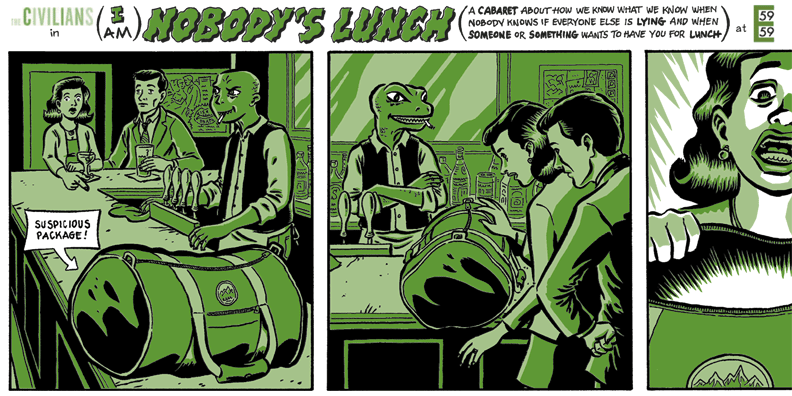AUTHOR’S NOTE:
As the culmination of the Research and Development group approaches, the Civilians’ own practice of inquiry, interviewing and devising has popped into mind with increasing frequency. “But wait,” you ask. “What do these two things have to do with each other?” Nothing short of everything. At Findings, artists share their discoveries with a wider audience, like scientists presenting a breakthrough in Physics or Biology. With this metaphor in mind, what I am proposing in the following “recipes” is a process by which someone might go about conducting their own experiments.
The Civilians’ process is empathetic, research driven, playful and portable; it is a way of turning deep listening into embodiment. In a moment like ours, where chaos and turmoil are ever present and empathy reserves are low, I thought a peek behind the curtain might prove interesting and encouraging to theatergoers and theater makers alike. The method you will find outlined below is one particular way of generating theatrical work, but I believe it has something to offer anyone who is trying to be a more engaged community member, friend, or artist.
Bon appetit!
STEP ONE
Laying a foundation.
CONTEMPLATIVE PIECE I
Close your eyes.
Stare at the moon.
Ask yourself what is missing.
The dandelions will let you know.
CONTEMPLATIVE PIECE II
Line up all the missing pieces. (They may being whispering among themselves. Do not be alarmed.)
Catch these whispers in a glass jar, preferably on a spring day.
Place in a cool dark room. Do not disturb.
When your eyes have adjusted to the dim light, you may see yet another horizon.
Follow it home.
STEP TWO
How to begin.
INGREDIENTS
One (1) burning question or—the shape of the missing piece
One (1) recording device*
Someone who has an answer to your question—maybe one person, maybe 80. You decide.**
An open mind
Research and/or notes
DIRECTIONS
Approach the interviewee with care and respect. If you are meeting in person, try to conduct the conversation in a place connected to the subject at hand; context can play a bigger part than you know.
Always get permission before recording, and if you can get this permission on the record as well, so much the better for all involved.
Combine your curiosity with the interviewee’s experience(s). Ask open ended questions and/or simply give them space to talk about what is interesting and meaningful to them. At this stage, turn the heat to a lower setting, and reduce all judgments and expectations. Simmer.
If certain ingredients seem to increase the overall temperature, you may choose to add more of them, but do so carefully.
DO NOT LET THE MIXTURE REACH A BOIL.
Stir. Stir some more. Make sure to scrape the crusty bits from the bottom of the pan. At a certain moment, something may strike your imagination. Tease this out. Continue reducing, not your expectations this time, but the excess information until you’ve found your “hook.” Cover with active listening and presence.
When the conversation has reached a point of being “done”, thank your partner for their time and part ways.
Pour the audio into transcription software. Sift.
Sift some more. Strain the remaining elements for dramatic tension. If something catches your senses, preserve it. Transfer to a bowl. Taste it. What does it need?
You might get stuck here. If you do, try to recall the interview from memory. What parts where to most evocative to you? Once you’ve identified this, you may move to the next step.
Open your cabinets. Add everything you know, everything you want to know, secret longings, aberrant flavors, etc. Grease your favorite philosophical framework, formal convention, political concern or character archetype and pour your transcript in when it has been edited cooled. You may find however, that as you’ve been rumbling around in your kitchen, the dish has assembled itself into its own shape and has an internal structure you’ve never seen before.
Remain calm, if you can. Trust that the piece knows what it is even if you don’t.
Leave this combination in an oven for a few months. (Maybe years.
Once finished, serve to the delight and amazement of friends, family, and colleagues. Wait until the next burning question approaches. Begin again. And again. And again.
ADDENDUM
*In certain cases, a strange and slippery memory might be of more use than an exact transcript, but best practice necessitates some form of record-keeping for your sake, as well as the interviewees. No one wants to get burned. Or feel that they were, which is often the same thing.
**note: “an” answer is not the same as “the” answer.
Extended Play is a project of The Civilians. To learn more about The Civilians and to access exclusive discounts to shows, visit us and join our email list at TheCivilians.org.
Author
-

Faith Zamblé is a writer, culture worker, and artist at large, originally from Waukegan, IL.
View all posts










